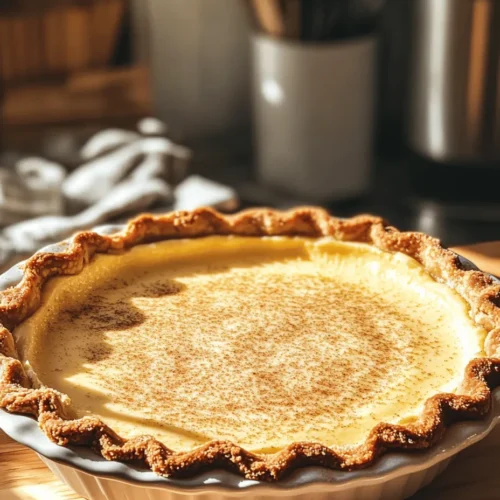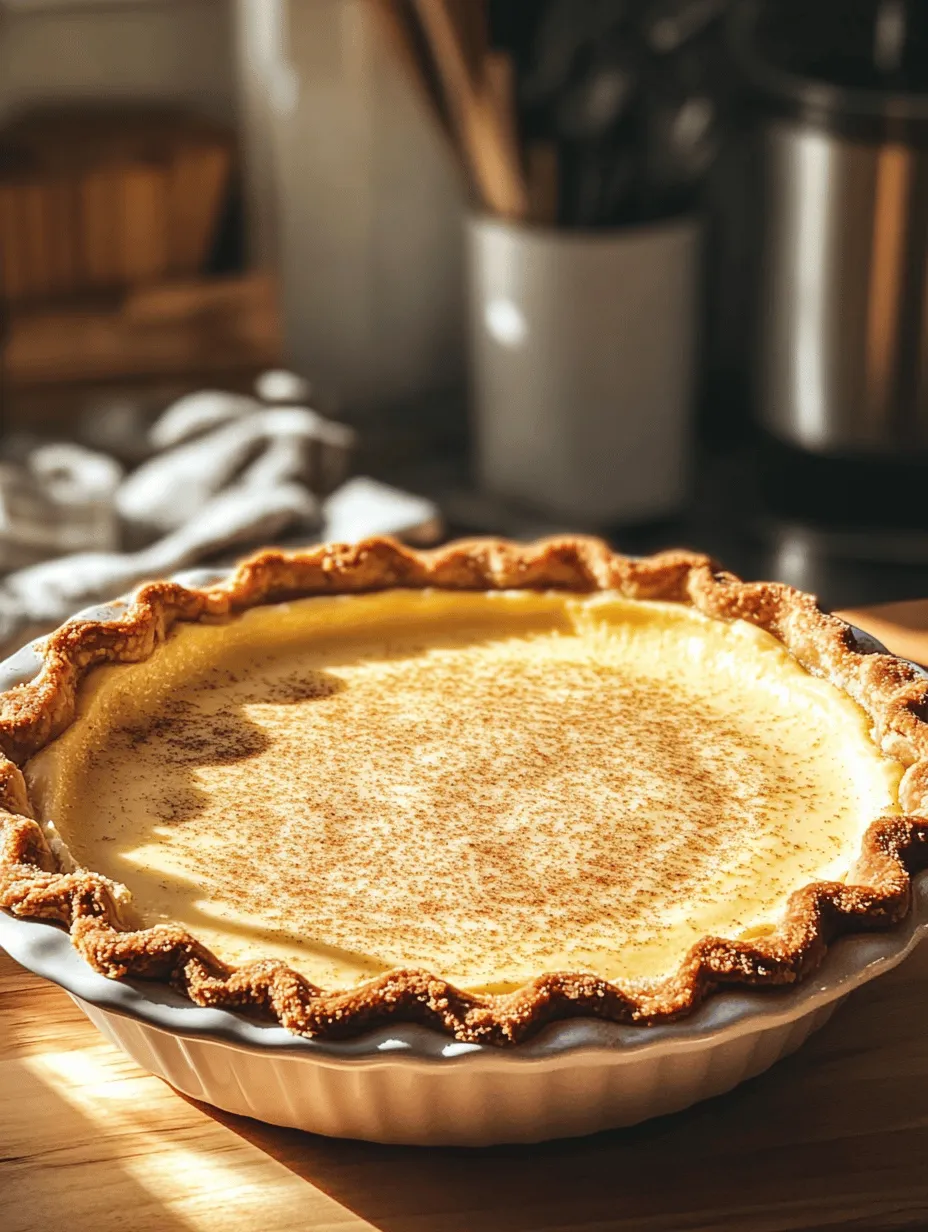In the realm of traditional desserts, few dishes evoke nostalgia quite like the Classic Old-Fashioned Egg Custard Pie. This beloved dessert, with its creamy filling and delicate balance of sweetness, has graced family tables for generations. With its golden crust and smooth, silky custard, egg custard pie is a hallmark of comfort food that transcends time and trends. Whether it’s a holiday gathering, a family reunion, or simply a cozy evening at home, this pie brings warmth and comfort to any occasion.
As we embark on this culinary journey, we’ll delve into the rich history of egg custard pie, explore its key ingredients, and guide you through each step of the preparation process. By the end of this article, you’ll be equipped with all the knowledge you need to create a perfect custard pie that will impress your family and friends.
The Rich History of Egg Custard Pie
Exploring the Origins of Egg Custard Pie
The origins of egg custard pie can be traced back to the early days of American history, where custards were a popular dessert choice due to their simplicity and versatility. The concept of custard itself dates back to medieval times, originating from Europe, particularly in France and England. It was during the colonial era that egg custard pie began to take root in American kitchens, celebrated for its rich flavor and creamy texture.
Historically, custard pies were made with basic pantry staples—eggs, milk, and sugar—making them accessible to many households. As they became a staple in American baking, variations began to emerge, each region adding its own twist, influenced by local ingredients and cultural preferences. The egg custard pie, in its classic form, became a symbol of home-cooked comfort, often served at family gatherings and special occasions.
Understanding its Popularity Across Generations
The popularity of egg custard pie endures across generations, cherished not just for its taste but also for the memories it evokes. Many people recall the comforting aroma wafting through the kitchen as it bakes, and the anticipation of slicing into that golden crust to reveal the creamy filling. It’s a dessert that often finds its way onto the tables of holiday feasts, accompanying other traditional dishes, and fostering a sense of nostalgia that connects us to our past.
As culinary trends have evolved, the classic egg custard pie remains a beloved choice, appealing to both young and old alike. Today, it is frequently featured in cookbooks, food blogs, and cooking shows, reminding us of the importance of preserving these time-honored recipes. The pie not only satisfies a sweet tooth but also serves as a reminder of family traditions, making it a dessert that is rich in both flavor and history.
Cultural Variations and Regional Twists on the Classic Recipe
While the Classic Old-Fashioned Egg Custard Pie holds a special place in American cuisine, it has inspired a variety of regional adaptations and cultural variations. In the Southern United States, for instance, the pie often features a touch of vanilla or nutmeg, enhancing its flavor. Some versions incorporate a hint of cinnamon or even coconut, while others might use sweetened condensed milk to create a different texture.
In New England, egg custard pie is sometimes prepared with a buttery crust and a sprinkle of nutmeg on top, providing a delightful contrast to the creamy filling. Meanwhile, in the Midwest, variations may include adding fruits like apples or berries, transforming the classic recipe into a delightful fusion of flavors.
These regional twists showcase the versatility of the egg custard pie, demonstrating how a simple recipe can evolve and adapt to local tastes and traditions. Regardless of the variation, the essence of the custard pie remains the same—a comforting, creamy dessert that continues to bring joy to tables everywhere.
Understanding the Ingredients for Egg Custard Pie
To create a truly remarkable Classic Old-Fashioned Egg Custard Pie, it’s essential to understand the role of each ingredient in the recipe. Below, we’ll break down the key components that contribute to the pie’s luscious texture and flavor.
Overview of Essential Ingredients
1. Eggs: The backbone of any custard, eggs provide structure and richness to the filling.
2. Whole Milk: This ingredient not only adds creaminess but also helps to create a smooth texture.
3. Granulated Sugar: Balancing sweetness is crucial, as sugar enhances the flavor without overpowering it.
4. Vanilla Extract: A staple in baking, vanilla extract imparts a warm, aromatic quality to the custard.
5. Salt: A pinch of salt elevates the flavors, ensuring a well-rounded taste.
6. Nutmeg: This warm spice adds depth and complexity, making the pie more aromatic.
7. Optional Cornstarch: Some recipes may call for cornstarch to help thicken the custard and improve its consistency.
The Role of Eggs in Custard Formation
Eggs are the star of the show when it comes to making custard. They serve two primary functions: they provide structure and create a creamy, smooth texture. When eggs are combined with milk and heated, the proteins in the eggs coagulate, thickening the mixture. This process transforms the liquid custard into a silky filling that sets beautifully once baked.
Using fresh, high-quality eggs is essential for achieving the best flavor and texture. The yolks contribute richness, while the whites provide stability. For a perfectly smooth custard, it’s essential to whisk the eggs thoroughly to break them up before adding them to the other ingredients.
The Importance of Whole Milk for Creaminess
Whole milk is the preferred choice for creating a rich and creamy custard. Its higher fat content compared to low-fat or skim milk contributes to a velvety texture that’s synonymous with classic custard pies. The fat in whole milk enhances the overall mouthfeel, making each bite indulgent.
If you’re looking for a lighter version, you could use a combination of whole milk and cream, but be cautious not to alter the balance too much, as the custard’s flavor is best when it retains its classic essence.
Granulated Sugar: Balancing Sweetness and Flavor
Granulated sugar is essential for sweetening the custard, but its role extends beyond just adding sweetness. Sugar also enhances the flavors of the other ingredients, particularly the eggs and vanilla. When using sugar, it’s important to measure accurately to ensure that the custard is neither too sweet nor too bland.
For those who prefer a less sweet custard, consider reducing the sugar slightly, but keep in mind that sugar also affects the texture of the filling. A well-balanced sweetness will elevate the overall experience of the pie.
Vanilla Extract: Enhancing Aroma and Taste
Vanilla extract is a key ingredient that brings warmth and depth to the custard filling. Its fragrant aroma complements the richness of the eggs and milk, creating a harmonious blend of flavors. When selecting vanilla extract, opt for pure vanilla for the best taste, as artificial vanilla can lack the complexity and authenticity needed for a classic dessert like this.
Salt and Nutmeg: Adding Depth and Complexity
Don’t underestimate the power of salt in dessert recipes. A pinch of salt enhances the sweetness and rounds out the flavors, ensuring that the custard tastes well-balanced. Similarly, nutmeg adds a hint of warmth and spice, making the pie more aromatic and inviting. Use freshly grated nutmeg if possible, as it delivers a more vibrant flavor than pre-ground varieties.
Optional Cornstarch: Achieving the Perfect Consistency
While traditional egg custard pie recipes may not include cornstarch, some bakers opt to add it for a thicker consistency. Cornstarch acts as a stabilizer, ensuring that the custard sets perfectly without becoming overly runny. If you choose to use cornstarch, mix it with a bit of the milk before incorporating it into the egg mixture to prevent clumping.
Preparing the Perfect Pie Crust
A delightful custard filling deserves a flaky, tender pie crust to cradle it. When it comes to pie crusts, you have two primary options: store-bought or homemade. Each option has its pros and cons, and your choice may depend on your baking experience, time constraints, and personal preferences.
Choosing Between Store-Bought and Homemade Crusts
Store-bought pie crusts offer convenience and save time, especially for those who may be intimidated by the process of making a crust from scratch. They’re widely available and can be a great option for busy bakers. However, homemade pie crusts often provide superior flavor and texture, allowing for customization to suit your tastes.
If you decide to go the homemade route, you’ll enjoy the satisfaction of creating a crust that perfectly complements your custard filling. The choice ultimately comes down to your comfort level in the kitchen and how much time you have to devote to the preparation.
Step-by-Step Guide to Making a Homemade Pie Crust
If you choose to make your own pie crust, here is a simple step-by-step guide to get you started:
1. Gather Ingredients: You’ll need all-purpose flour, unsalted butter (cold and cut into cubes), salt, and cold water.
2. Mix Dry Ingredients: In a large mixing bowl, combine 1 ½ cups of all-purpose flour and ½ teaspoon of salt.
3. Cut in Butter: Add the cold cubed butter to the flour mixture. Using a pastry cutter or your fingertips, work the butter into the flour until the mixture resembles coarse crumbs.
4. Add Cold Water: Gradually add 3-4 tablespoons of cold water, mixing gently until the dough begins to come together. Be careful not to overmix; you want to maintain some small bits of butter for a flaky texture.
5. Form the Dough: Shape the dough into a disk, wrap it in plastic wrap, and refrigerate for at least 30 minutes. This step helps to relax the gluten and makes rolling easier.
Tips for Rolling and Fitting the Crust into the Pie Pan
When you’re ready to roll out the chilled dough, dust your work surface with a little flour to prevent sticking. Using a rolling pin, gently roll the dough into a circle that’s about 1/8 inch thick.
Fitting the Crust: Carefully transfer the rolled-out dough into your pie pan by rolling it around the pin and then unrolling it over the pan. Gently press it into the bottom and sides of the pan, being cautious not to stretch the dough.
Trimming and Crimping: Trim any excess dough hanging over the edges, leaving about ½ inch of overhang. Fold the overhang under itself and crimp the edges with your fingers or a fork to create a decorative border.
Chilling the Crust: Why It’s Crucial for Texture
After fitting the crust into the pie pan, it’s essential to chill it again before baking. This step allows the gluten to relax further and helps prevent shrinking during baking. Chill the crust for at least 30 minutes in the refrigerator or 15 minutes in the freezer.
Now that you have a solid understanding of the history and ingredients for crafting the Classic Old-Fashioned Egg Custard Pie, as well as the steps to prepare the perfect pie crust, you’re well on your way to creating this timeless dessert. In the next section, we will dive into crafting the creamy custard filling, ensuring your pie is a delightful centerpiece for any occasion.

The Importance of Beating the Eggs Properly
When making a classic egg custard pie, the eggs serve as the foundation for the custard filling. Properly beating the eggs is crucial to achieving a light and airy texture. Begin by cracking your eggs into a mixing bowl and whisking them vigorously until the yolks and whites are fully combined. The goal is to incorporate air into the mixture, which will help create a smooth, fluffy custard. You should whisk for about 2-3 minutes until the mixture appears pale and slightly frothy.
Incorporating Milk for Smoothness
Once your eggs are beaten, it’s time to add the milk. The type of milk you choose can impact the flavor and texture of your custard pie. Whole milk is traditional and provides a rich, creamy consistency, but you can also experiment with half-and-half or even a combination of milk and cream for an indulgent touch. Gently pour the milk into your egg mixture, whisking continuously to combine. This step not only smooths out the custard but also helps to temper the eggs, preventing them from cooking too quickly when added to the hot mixture later.
Using Cornstarch for a Thicker Custard: When and How
Cornstarch is an essential ingredient when it comes to achieving the perfect thickness in your egg custard pie. It acts as a stabilizer, ensuring that your custard sets properly without becoming too runny. To use cornstarch, mix it with a small amount of the sugar before adding it to the egg and milk mixture. This prevents clumping and promotes even distribution throughout the custard. For a standard pie, about 2 tablespoons of cornstarch should suffice. Mix it in thoroughly, ensuring there are no lumps, before proceeding to the next steps.
Baking the Egg Custard Pie
Preheating the Oven: The Key to a Flaky Crust
Before you pour your custard into the pie crust, preheat your oven to 350°F (175°C). A properly preheated oven is essential for achieving a flaky crust. If the oven is too cool, the crust may become soggy. If it is too hot, the edges may burn before the custard has had a chance to set. Place your prepared pie crust on a baking sheet to catch any drips and make it easier to handle.
Understanding the Two-Temperature Baking Method
The two-temperature baking method involves starting your pie at a higher temperature and then reducing it. Begin by baking your pie at 425°F (220°C) for the first 15 minutes. This initial burst of heat helps to set the crust and gives it a beautiful golden color. After 15 minutes, reduce the temperature to 350°F (175°C) and continue baking for an additional 30-40 minutes, or until the custard is just set. This method ensures a perfectly baked pie with a crispy crust and a smooth filling.
Signs to Look for When the Pie is Done
Knowing when your egg custard pie is done can be tricky. Look for the custard to be set around the edges but still slightly wobbly in the center. It should not jiggle excessively, as this indicates that it needs more time. A good rule of thumb is to insert a knife into the center; if it comes out clean or with just a few moist crumbs, your pie is ready. Remember, the custard will continue to set as it cools, so it’s better to take it out a little early than too late.
Cooling and Serving the Pie
The Importance of Cooling to Set the Custard
Once you’ve baked your pie to perfection, it’s essential to let it cool. This cooling period allows the custard to set fully. Place the pie on a wire rack at room temperature for at least 1-2 hours. Avoid the temptation to rush this step, as cutting into the pie while it’s still warm can result in a runny custard.
Garnishing the Pie with Nutmeg: A Classic Touch
A sprinkle of nutmeg on top of your egg custard pie adds a classic and aromatic touch. Use freshly grated nutmeg for the best flavor, and sprinkle it over the surface of the pie right before serving. This not only enhances the presentation but also complements the sweet, creamy custard beautifully.
Chilling vs. Serving at Room Temperature: What You Need to Know
Egg custard pie can be enjoyed either chilled or at room temperature, depending on your preference. For a more refreshing experience, chill the pie in the refrigerator for at least 4 hours before serving. This can enhance the flavors and make for a delightful dessert on a hot day. If you prefer it at room temperature, simply let it sit out for about an hour before serving.
Common Questions About Egg Custard Pie
What Makes Egg Custard Pie Different from Other Custards?
Egg custard pie is unique due to its combination of eggs, milk, sugar, and flavorings baked in a crust, resulting in a firm yet creamy filling. Unlike other custards that may be served in cups or ramekins, egg custard pie is a complete dessert that’s easy to slice and serve.
How to Store Leftover Pie for Maximum Freshness
To store leftover egg custard pie, cover it loosely with plastic wrap or aluminum foil and keep it in the refrigerator. It will stay fresh for up to 3-4 days. If you want to maintain the crispness of the crust, consider placing a piece of parchment paper between the pie and the cover.
Can Egg Custard Pie Be Made Ahead of Time?
Yes, egg custard pie is an excellent make-ahead dessert. You can prepare and bake it a day or two in advance, allowing the flavors to meld and deepen. Just be sure to store it in the refrigerator, and it will be ready to serve when you are.
Nutritional Information and Serving Suggestions
Nutritional Breakdown of Classic Egg Custard Pie
A slice of classic egg custard pie typically contains around 250-300 calories, depending on the size of the slice and the ingredients used. It usually consists of carbohydrates, fats, and protein, making it a satisfying dessert option. For those monitoring their sugar intake, consider reducing the sugar slightly or using a sugar substitute.
Pairing Suggestions: Best Accompaniments for Your Pie
Egg custard pie pairs exceptionally well with a variety of accompaniments. Consider serving it with a dollop of freshly whipped cream, a scoop of vanilla ice cream, or a drizzle of caramel sauce. Fresh fruits like berries or sliced peaches can also complement the creamy texture of the pie beautifully.
Creative Serving Ideas: From Whipped Cream to Fresh Fruits
Get creative with your presentation! Serve individual slices topped with a sprinkle of cinnamon or a few candied pecans for added texture. For a more elegant touch, create a fruit compote by simmering fresh berries with a bit of sugar and lemon juice, and spoon it over the custard pie just before serving.
Conclusion: Enjoying the Timeless Delight of Egg Custard Pie
In conclusion, the Classic Old-Fashioned Egg Custard Pie is not just a dessert; it’s a slice of history and tradition that can bring people together. With its simple yet elegant flavor profile, this pie serves as a reminder that sometimes the most comforting dishes are the ones that have been passed down through generations. By following our guide, you can create a delicious egg custard pie that embodies the heartwarming essence of home cooking, ensuring that this cherished recipe continues to be enjoyed for years to come. Whether you serve it at a holiday gathering, a family dinner, or simply as a treat for yourself, this timeless dessert will surely delight everyone who tastes it.



